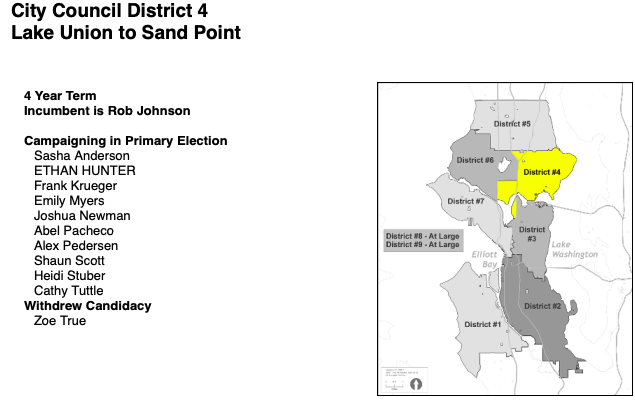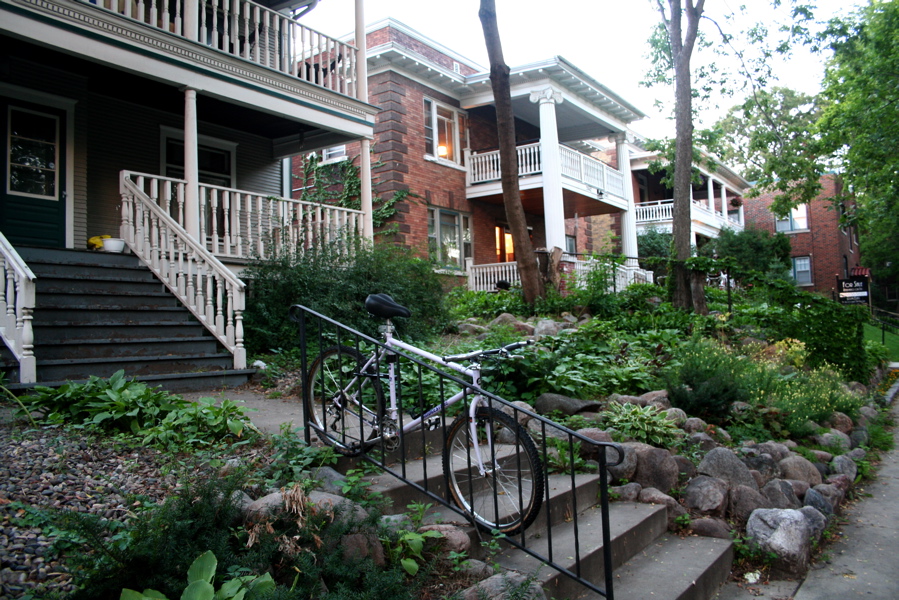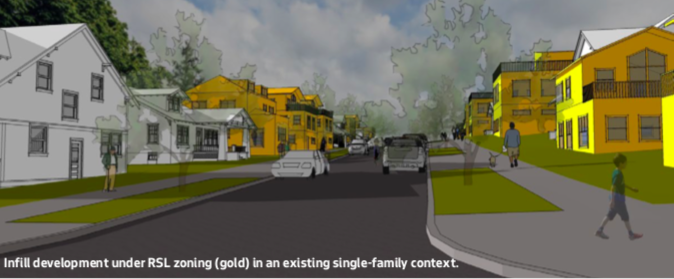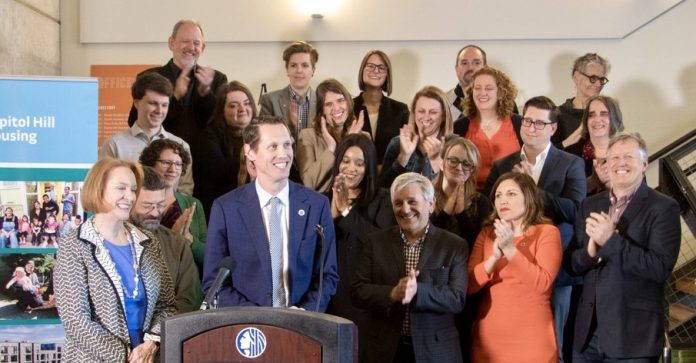After ushering in the expansions of Mandatory Housing Affordability (MHA) to all of Seattle’s urban villages with a unanimous vote, District 4 Councilmember Rob Johnson left elected office early to pursue a new transportation advising position with the NHL Seattle. The group is bringing an National Hockey League expansion team to Seattle Center Arena that will play its inaugural season in 2021.
Johnson, who said he never planned to serve more than one term, held his last day in office on April 5th. The Council has 20 days to appoint someone to hold the District 4 seat until November 26th when the newly elected councilmember takes office. Meanwhile, 10 candidates have qualified to run in the primary for District 4, and even more candidates have filed and been denied or expressed intention to file for the primary, making it the most crowded district race in the upcoming election.

The Stranger might have dubbed him “Quittin’ Rob Johnson,” but it is undeniable that it has not been easy to be Rob Johnson in recent years. Johnson’s positions in favor of protected bike lanes, zoning for residential density, and public transit stoked the anger of the pro-car set both within and outside of his district. His support for protected bike lanes on 35th Avenue NE led to tweets that called him a “dead man walking.” Editorials, like this one published by KIRO, calling Rob Johnson a “soulless liar” show in vivid color the kind of vitriol he dealt with on a regular basis.
During his last hectic hours representing District 4, Johnson made time to speak to The Urbanist about what he learned during his time on the Council, what it was like to work with Mayor Jenny Durkan, and his hopes for Seattle’s housing and transportation future.
MHA: A hard won accomplishment with lessons learned along the way
Johnson remains proud of his leadership role in passing citywide implementation of MHA. “It was the first time since urban villages were adopted in the nineties that the city approved such a sweeping change,” Johnson said.
While many pro-density advocates were dismayed by the passage of amendments to MHA legislation that decreased upzones in specific areas, such as Johnson’s own Ravenna-Cowen neighborhood in District 4, Johnson stated that such compromise was worth it because it resulted in unanimous support for city-wide implementation of MHA among the nine councilmembers.
“Urbanists need to recognize that unanimity was only possible because of district self-determination. It was the critical key to getting unanimity. If either myself or Lorena Gonzalez (Planning, Land Use, & Zoning committee co-chair) had said, ‘Here’s the vision we have for your neighborhood and we are going to ignore what you feel is important for your neighbors,’ we would not have been successful. Neighborhood self-determination really mattered.”
Rob Johnson
Johnson believes that the council’s unanimous support will protect the MHA legislation in the long run. As an example, he referenced the broad support for MHA among city council primary candidates.
At the same time, with hindsight as a guide, Johnson believes that certain aspects of the MHA process could have been handled better. For starters, he wishes that he would have had more input with the City planning department in regards to the environmental analysis. “We were hamstrung in a lot of ways and couldn’t discuss potential tradeoffs with neighborhoods,” Johnson said. As an example he referenced Ravenna-Cowen, where some residents stated a preference for higher upzones near the coming light rail station, but more limitations on upzones at the edges of the neighborhood.
He also wishes that the work could have been completed and implemented quicker so that the city would already be reaping more of the affordable housing benefits of MHA. “Under the Murray administration, we showed that good planning can occur under a compressed timeline and still achieve the majority of outcomes people want,” Johnson said.
What’s next for housing affordability?
Like many affordable housing advocates in Seattle, Johnson would like to see the passage of Minneapolis style reform of the single-family zoned neighborhoods. Minneapolis gained national attention in late 2018 when the city ended single family zoning. The mayor and other city officials cited persistent racial inequity in Minneapolis as a major motivation for the change.

Seattle City Council approved Councilmember Teresa Mosequeda’s request to conduct a Race and Equity Toolkit (RET) analysis of single-family zoning in Seattle. Some advocates hope that this will be Seattle’s first step for ending this type of exclusionary zoning.
However, while Johnson is optimistic that Seattle could follow in Minneapolis’s footsteps, he also cautioned that the Washington State Environmental Protect Act (SEPA) would slow down Seattle’s implementation process. One of the reasons Minneapolis was able to pass the zoning changes so quickly was the lack of SEPA process and regulations.
Nevertheless, Johnson is optimistic that similar zoning overhaul could come to Seattle and believes that extending the Residential Small Lot (RSL) zoning application to all single family zones provide an elegant solution.

RSL is a zoning designation that allows for the construction of smaller homes and duplexes, with the intention of adding more housing capacity without destroying the architectural fabric of current single family home zones. Under “City-wide” MHA, RSL was greatly expanded from seven acres of zoned land in Seattle to roughly 768 acres, including about 6200 Single Family Lots. Expanding it further would allow for more housing to built in single family zones. Some skeptics argue RSL will not result in much new housing construction because the addition of MHA fees makes it prohibitively expensive to construct the types of modest housing permitted under RSL zoning.
Transportation advocates need to be proactive with Mayor Durkan
During her time in office Mayor Jenny Durkan has received criticism for decisions like delaying completion of the Center City Connector streetcar and scaling back the Bicycle Master Plan. Johnson believes that transportation advocates have focused too much on the negative and that it is possible to work effectively with Mayor Durkan.
“In my years of experience, the most effective advocacy I ever saw coalesced around a unified vision and held people accountable, but did so in a way that did not exclusively use negative framing,” Johnson said. In his opinion, outside of the city offices, advocates have been applying too much of a “bad cop” approach to Mayor Durkan’s decision-making.
“It’s possible to work with the Mayor,” Johnson said. “We need to be proactive.”
Ultimately, Johnson believes that both currently discouraged transportation advocates and the Mayor hold a similar vision for what they want Seattle’s future to be, and that a more positive approach (e.g., good cop in addition to bad cop) would be beneficial for achieving that vision.
Johnson will continue his advocacy for urbanism in Seattle
Johnson is adamant that while he is leaving elected office, he is “not going anywhere” and plans to continue his nearly two decades of advocacy for sustainable transportation reform. In his new role for NHL Seattle, Johnson will be responsible for getting crowds of more than 17,000 spectators to NHL games, an amount that comes in addition to the thousands of visitors who already patronize other attractions at Seattle Center.

Managing the transportation of crowds of this size will be complex, particularly because light rail is not planned to open at Seattle Center until 2035. In the interim, Johnson aims to improve access and connectivity to existing transit. Also, undeterred by his long travails with the ultimately doomed 35th Avenue NE protected bike lane, Johnson wants to make it safer and more accessible to travel to Seattle Center by bike.
Even in an era when SDOT is scaling back on plans for bike infrastructure, Johnson is interested in reviving the concept of the “Emerald Mile,” a protected bike lane that would run on 5th Avenue through downtown to Seattle Center beneath the current route of the Monorail. The plan was first hatched in 2015, but did not gain traction as a result of opposition from local businesses.
Johnson is also interested in learning from “fun strategies that really work” to ease the transportation squeeze, such as the Sounders March to the Match, which brings large numbers of fans to the stadium on foot while creating a memorable community event.
Transportation is a climate issue
Johnson believes that focusing on transportation is important because is a “big solution” for our current climate crisis. “We have reserved too much right of way for cars,” said Johnson, who believes that advocates need to “push hard for a redistribution of right of way” that more equitable shares road space with transit, pedestrians, and cyclists.
“I think it’s fair to say that as a society we have not really internalized all of the negatives externalities that are associated with current patterns of driving and land use,” Johnson said.

Decongestion pricing is one potential solution that Johnson supports, however, he cautions that “We need to work on the framing so that people will buy in.” In order to do so, he believes that it is essential to integrate a focus on equity outcomes into the conversation.
In general, Johnson believes that Seattle should be focusing on “near-term impacts” and “quickly implementable solutions,” that would improve our current infrastructure for walking, biking and transit.
One of the most important ways to ensure that this occur will be for the future City Council to vote in approval of the next Seattle Transportation Benefit District (STBD) package. STBD funds essential transit, like expanded Metro bus services. Adequate funding for the STBD will be essential for maintaining and increasing transit coverage in Seattle.
Natalie Bicknell Argerious (she/her) is a reporter and podcast host at The Urbanist. She previously served as managing editor. A passionate urban explorer since childhood, she loves learning how to make cities more inclusive, vibrant, and environmentally resilient. You can often find her wandering around Seattle's Central District and Capitol Hill with her dogs and cat. Email her at natalie [at] theurbanist [dot] org.



